
This mighty river is 981 miles in length! The Ohio River starts at the Midwestern and Southern United States boundary and ends where it joins the Mississippi River in Cairo, Illinois. This river is the widest at the Smithland Dam in Kentucky, with an approximate width of one mile. Furthermore, its average depth is around 24 feet.
The Ohio River contains approximately 160 fish species and provides more than five million people with drinking water. However, this does not mean that it’s free of pollution.
So, continue reading to learn about what is in the Ohio River and if it’s safe to swim in its waters.
Pollution In the Ohio River
Sadly, the Ohio River is one of the most polluted rivers in the United States. Its highly industrialized and populated banks are the main factors contributing to this river’s polluted state. Additionally, it has served as a dumping site for local industries and cities for generations. While many steps have been taken to clean up the river, there is still a long way to go.

The Ohio River is one of the most polluted rivers in the United States.
©Anne Kitzman/Shutterstock.com
Is it Safe to Swim In the Ohio River?
The answer to this question depends on location and time of year. So, the risks of swimming in the Ohio River include:
- River currents
- Submerged or floating debris
- Recreational and commercial traffic
- Poor water quality
There may be possible human health risks due to water quality conditions. For example, when there is a lot of heavy rain, the stormwater mixes with sanitary waste, and an overflow occurs, which runs into the Ohio River. Therefore, swimming in the summer, when there is less rain, is safer than in the rainy season during winter. However, there are a lot of recreational activities on this river, so stick to the areas where designated signs say it’s okay to swim.
What Lives in the Ohio River?
There are over 160 fish species in the Ohio River, not to mention all the other wildlife that inhabits its waters. Here are just some of the fish and snakes that occur in this river:
Sauger
The sauger is often confused with walleye or a hybrid between the two species named the saugeye. They have multiple dark spots forming rows on their dorsal fin. In addition, their body coloration is brown or bronze, which differs from the walleye, which is usually more gray or silver. The sauger also has dark oblong patches on the sides of its body, but it’s hard to see them while the fish is swimming. These fish belong to the Percidae family, along with darters and perches. Adults generally weigh less than a pound and measure 9 to 15 inches long. However, some trophy-sized specimens can reach 7 pounds and 24 inches.
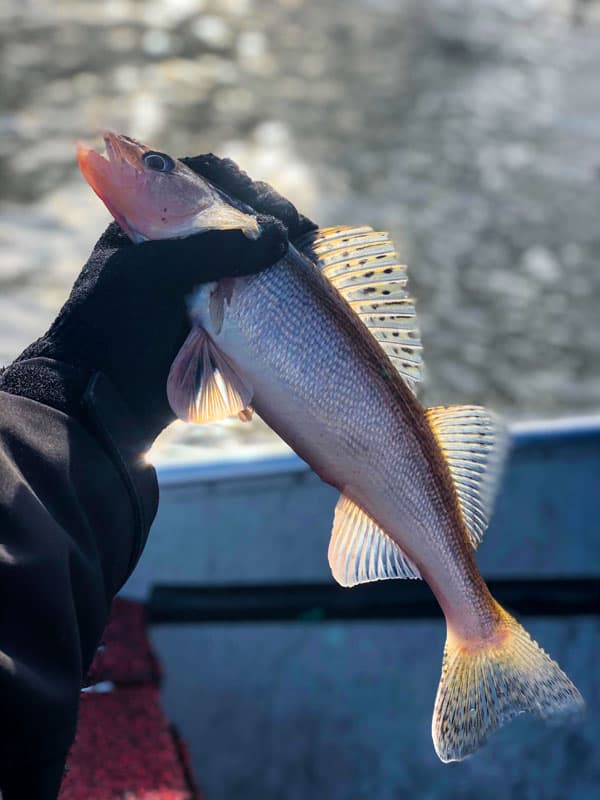
The sauger has dark oblong patches on the sides of its body, but it’s hard to see them while the fish is swimming.
©Benjamin D Johnson/Shutterstock.com
Walleye
The walleye is a predatory fish equipped with many sharp teeth. These fish are typically gray, olive, or silver and have a series of dark patterns over their backs. Furthermore, the edges of a walleye’s tail and anal fins are white. They are often referred to as walleyed pike, pickerel, yellow pike, and while salmon. And, like the sauger, they belong to the Pericdae family. Walleyes generally weigh between 2 to 4 pounds and measure 14 to 22 inches. However, their maximum weight and length are approximately 16 pounds and 36 inches.
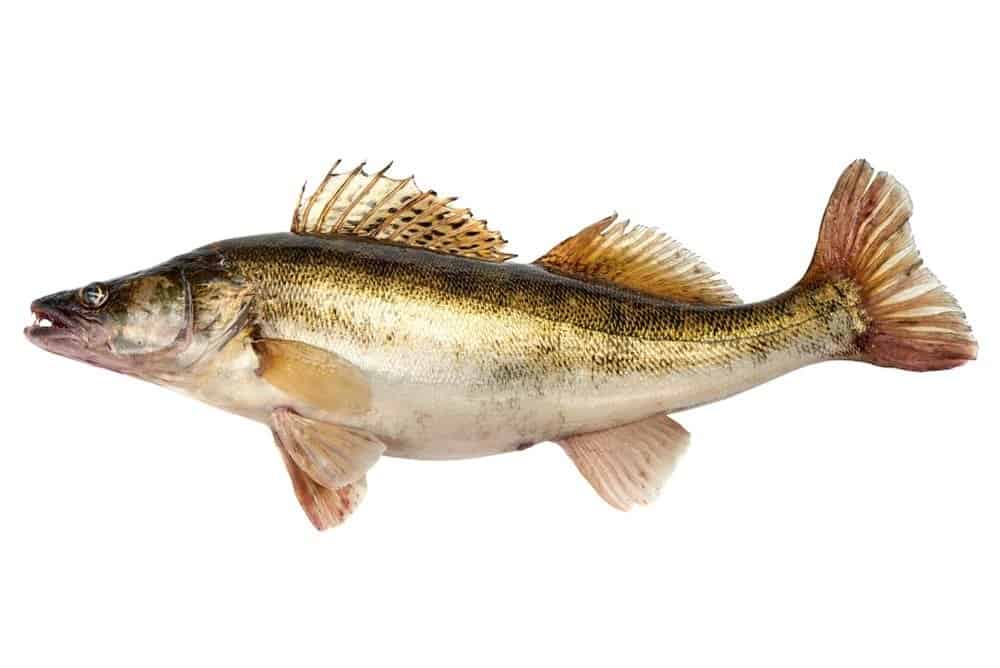
Walleye fish are typically gray, olive, or silver and have a series of dark patterns over their backs.
©GSDesign/Shutterstock.com
Largemouth Bass
The largemouth bass derived their name from their enormous mouths that stretch beyond the rear edge of the eye when their mouths are closed. This identifying feature distinguishes them from the spotted and smallmouth bass. In addition, largemouth bass also have a black stripe that runs down the side of their bodies. These large fish are also called bucket bass, black bass, and bigmouth bass and belong to the Centrachidae family. Furthermore, they weigh between 1 to 5 pounds and measure around 15 to 18 inches. However, they can weigh up to 13 pounds and can reach lengths of 26 inches in Ohio.
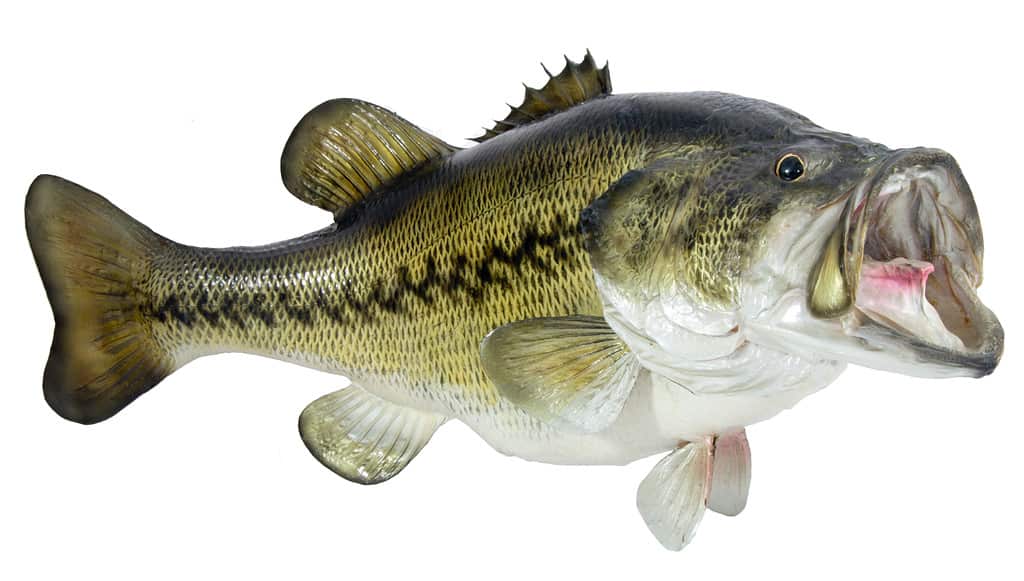
The largemouth bass is also called bucket bass, black bass, and bigmouth bass and belongs to the Centrachidae family.
©iStock.com/Joe_Potato
Blue Catfish
The blue catfish’s body is silver or light gray in color, and it has a deeply forked tail. They derived their name from the blue hue on their bodies, which is more pronounced on the top of their heads and on their backs. You can distinguish them from channel catfish by their anal fins, which are longer. For example, the blue catfish has 30 to 36 rays, while the channel catfish has between 24 to 30 rays.
The blue catfish belong to the Ictaluridae family, along with the other species of North American catfish. Furthermore, they are often referred to as white catfish. These fish are generally 20 to 40 pounds and grow 30 to 40 inches long. However, they can measure 60 inches long, and Ohio’s largest record for blue catfish was a whopping 96 pounds! But, there are records of blue catfish reaching over 120 pounds and 6 feet long in other states.
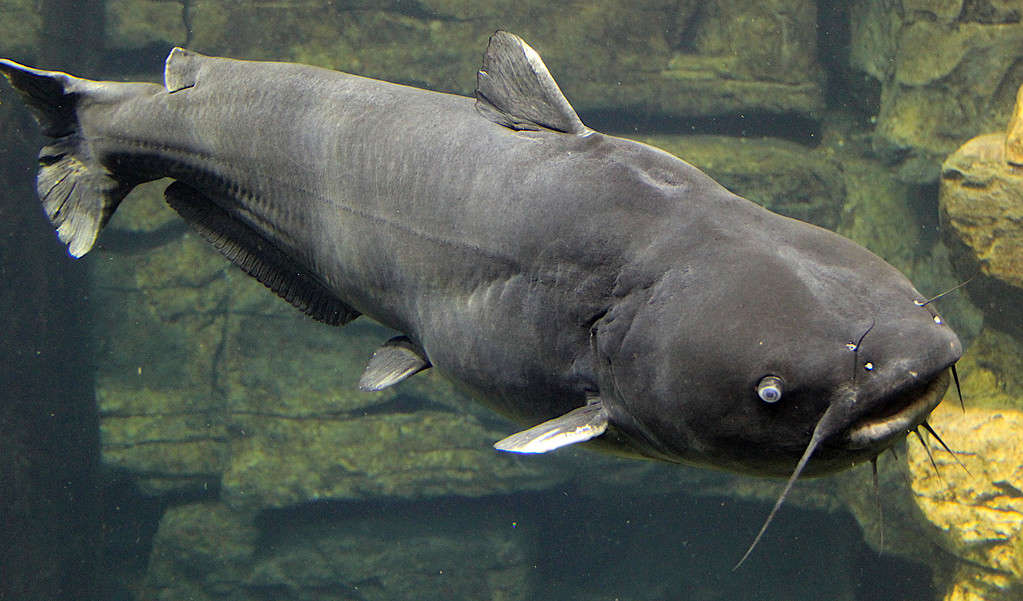
Blue catfish are generally 20 to 40 pounds and grow 30 to 40 inches long.
©Thomsonmg2000, cropped and adjusted by Kostka Martin / CC0 – License
Queen Snake
Adult queen snakes are typically 24 inches long, although some specimens reach 36 inches in length. They are either olive green or brown, with two light stripes running down the sides of their bodies. Their bellies are tan or yellow, with four dark stripes running their abdomens. These snakes love water and usually inhabit rivers with rocky bottoms or areas around streams. In addition, their skin is permeable, making queen snakes susceptible to water loss, which is why they are mostly found near water. Queen snakes are mainly diurnal and love to bask on rocks, vegetation near the water’s edge, or overhanging branches. But, when they sense danger is near, they take refuge under rocks along the banks of streams or rivers.
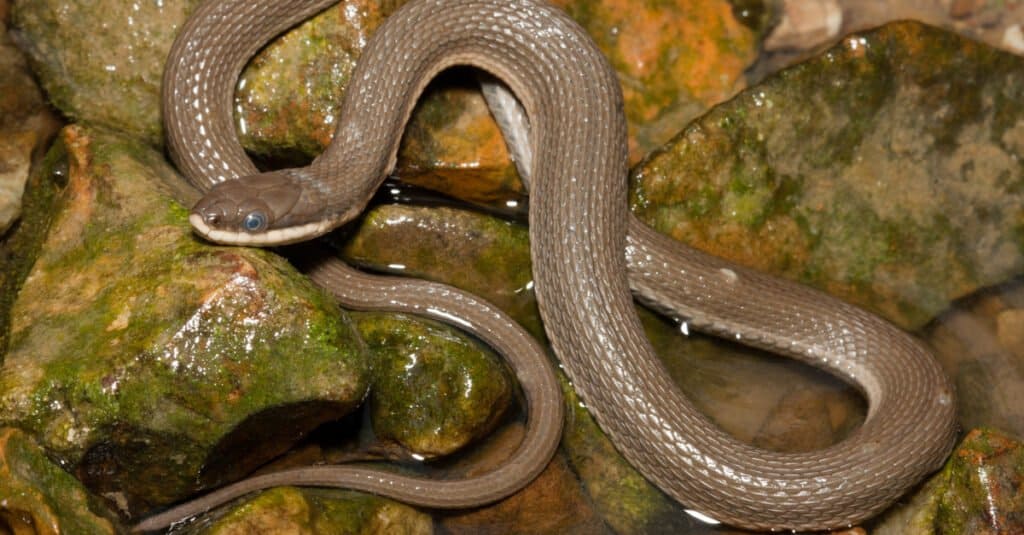
Queen snakes are mainly diurnal and love to bask on rocks, vegetation near the water’s edge, or overhanging branches.
©Nathan A Shepard/Shutterstock.com
Ribbonsnake
The ribbonsnake is a common garter snake species in Eastern North America. Luckily, they are non-venomous. Ribbonsnakes belong to the family Colubridae and can measure between 16 to 35 inches. This snake is dark brown with bright yellow stripes; females are thicker than males. They prefer wet climates and occur in:
- Wet woodlands
- Marsh areas
- Creek beds
- Streams
- Lakes
In addition, they are mainly active from April to October and hibernate during the colder months. Ribbonsnakes reach sexual maturity at three years old.
Common Watersnake
One of the most widely distributed and abundant snake species in Ohio is the common watersnake. In fact, it may inhabit just about any permanent body of water. Unfortunately, it is hard to identify this snake as it shows extreme variations in patterns and color and is often confused with the venomous cottonmouth or water moccasin. However, thankfully the cottonmouth does not occur in Ohio. Common watersnakes can grow to 43 inches long and love basking in the sun, where they are often seen on rocks, stumps, logs, or low branches hanging over the water.
But, chances of seeing them are very rare as they are wary and quickly disappear into the water if they hear anything approaching. These snakes are very aggressive when handled. They will bite if provoked, which can cause deep and painful lacerations. Additionally, if they are picked up, they will secrete a foul smell.

Common watersnakes can grow to 43 inches long and love basking in the sun, where they are often seen on rocks, stumps, logs, or low branches hanging over the water.
©Patrick Coin / CC BY-SA 2.5 – License
Where is the Ohio River Located on a Map?
Stretching across 981 miles, the Ohio River meanders along the boundary between the Midwestern and Southern regions of the United States. Starting in western Pennsylvania, the river flows in a southwesterly direction until it reaches its convergence with the Mississippi River at the southern tip of Illinois.
Here is the Ohio River on a map:
The photo featured at the top of this post is © ESB Professional/Shutterstock.com
Thank you for reading! Have some feedback for us? Contact the AZ Animals editorial team.






